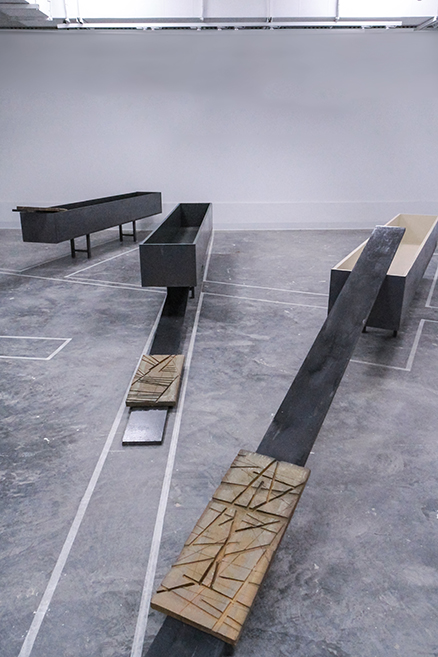MEMORY – FRAGMENT 3 – NY USA – 2017
Exhibition at New York State College of Ceramic Arts
ON MEMORY AND ITS SHADOWS
The telling of a nation’s history, the weaving of village narratives these are tapestries stitched from collective memory.
What is chosen to be remembered, what is left to fade, shapes the contours of history, a story sculpted by what is deemed
worthy of recall. For a human life, bound between the first breath and the last, memory is the vessel that carries our personal histories,
our fleeting moments stored within us like fragments of time.
“The life of the dead is set in the memory of the living.”
—Marcus Tullius Cicero, Phillips Pics 3.1.106-7.12.43
THE NATURE OF MEMORIES
The mental capacity or faculty of retaining and reviving facts, events, impressions, etc., or of recalling or
recognizing previous experiences. http://www.dictionary.com/browse/memory
For psychologists the term memory covers three important aspects of information processing:
Encoding: When information comes into our memory system (from sensory input), it needs to be changed
into a form that the system can cope with, so that it can be stored.
Storage: The nature of memory stores, i.e. where the information is stored, how long the
memory lasts for (duration), how much can be stored at any time (capacity)
and what kind of information is held. The way we store information affects the way we retrieve it.
Retrieval: This refers to getting information out storage.
If we can’t remember something, it may be because we are unable to retrieve it.
http://www.dictionary.com/browse/memory
IRVING AND BENJAMIN ON MEMORY
“Your memory is a monster; you forget—it doesn’t.
It simply files things away.
It keeps things for you, or hides things from you—and summons them to your recall with will of its own.
You think you have a memory; but it has you!”
John Irving, A Prayer for Owen Meany
While Benjamin wrote;
Every Image of the past that is not recognized by
The present as one of its concerns threatens to
Disappear irretrievably.
Benjamin
And so, memory is both keeper and betrayer, preserving, distorting, erasing a mirror held to time,
reflecting what we choose to see,and what is destined to vanish.
EXHIBITION AT – NEW YORK STATE COLLEGE OF CERAMIC ARTS
SUPPORTED BY
NEW YORK STATE COLLEGE OF CERAMIC ARTS
INVITED INTERNATIONAL THEODORE RANDALL CHAIR
SEE BOOK AT SAXO
OR AT CATALOG AND ARTICLES

Photo from local archive – Alfred University USA- NY – Photographer unknown.
Photos ; Installation 354 inches x 270 inches. Laser engraved Wood 25 x 12,5 inches x 1,5 inches, jr-tile clay fired at cone 6,
Wood object Linseed Oil painted 25 x 12,5 inches x 1,5 inches, 3 . Photos Anja.
LINES OF MEMORIES –RE-IMAGING TIME
ABSTRACT
In spring 2017 I was invited for a Theodore Randall international Chair at New York State College of Ceramic Art,
School of Art and Design, Alfred University.
I here had to do Art research /an art project – as well teaching a Junior 2 System class, supervise and give critique of grad
Students and attend meetings. This page is presenting my art project LINES OF MEMORIES –
Re imaging time-Fragment 1 out of 5 fragments all together.
BACKGROUND
It was a project in its origin based on local history, topology, archaeology and architecture presented
at the opening as a guided tour containing 5 fragments:.
Fragment 1; “Landscape a video presented at Alfred Ceramic Art Museum, NY, USA
Fragment 2; “Lines” Permanent outdoor concrete earth installation
Fragment 3; “Memory” wood-ceramic Installation at New York State College of Ceramic art, School of Art and Design, Alfred University
Fragment 4; “Time” ceramic Installation at New York State College of Ceramic art, School of Art and Design, Alfred University
Fragment 5; “The End” out-door earth-ceramic Installation.
A fragment is defined as;
a part broken off or detached from
A fragment; an isolated, unfinished, or incomplete part
A fragment; an odd piece, bit, or scrap.
In my work I reflect on the nature of time and the narrative telling of local history mixed with my own personal
interpretation hereof. I am curious about how memories, founding’s and fragments or artifacts can be parts of
a constructed narration of a history, a nations history, a village history and my own personal history.
I am an artist my intention is not to be an historian nor an archaeologist.
The fragments were presented as 5 installations at Alfred ceramic Art Museum. NY, USA,
New York State College of Ceramic Art, School of Art and Design, Alfred University and
outside in public place in front of Alfred ceramic Art Museum.




